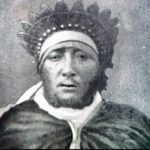MWATHA KOMBANA
- 4 Min Read
Mwatha Kombana (who flourished circa the 17th century) founded a Lunda-related chiefdom in the region between the Lutshiko and Loange rivers, about 160 km (100 mi) southeast of Kikwit. Begun as part of a general 17th-century pattern of Lunda conquest and expansion, the Kombana polity had a significant influence over the entire region between the Kwilu and Tshikapa rivers.
Some oral traditions claim that Lunda expansion began with Kinguri, who, in protest against the marriage of his sister Ruwej a Nkond with the Luba Chibind Yirung, left Lunda territory to settle elsewhere. Moving westward, he was responsible for founding the Kasanje state which his son, Kasanje Ka Imba, consolidated on the Kwango River in the early 17th century. Later the Shine state was founded by Kapenda Mukwa Ambungo, and the Yaka state by Mwene Putu Kasongo.
It was by following the example of Mwene Putu Kasongo that Mukelenge Mutombo (cousin of Chibind, or Ruwej, according to some tradition— or the favourite son of the Mwana Uta, under Chibind Yirung or Ruwei, according to others) left the Lunda area in search, like Kasongo, of Kinguri. He left Lundaland at the same time as Mai Munene, Chibind Yirung’s cousin, and moved towards the northwest. The most likely story is that Mukelenge Mutombo did not leave Lundaland of his initiative, but was sent, together with Mai Munene, by the Lunda court at Musumba to fight the Tufia people. Earlier in this era of Lunda conquest, Ruwej had sent her maternal uncle Mujinga north to fight the Tufia. Mujinga had been beaten shamefully, thus discrediting the court of Musumba. Therefore, Chibind Yirung sent “his son” Mukelenge Mutombo and Mai against the Tufia, whom they defeated. After the victory, Mai settled at the confluence of the Tshikapa and the Kasai. Mukelenge Mutombo, accompanied by several of his clans (Shakatwala, Kakinga Mutombo, Mwadi a Ngoya, and Kabeya), continued westward in hopes of finding Kinguri.
Mukelenge Mutombo, however, never realised his original intentions for, after crossing the Lovua River, in about 1650, he settled at the confluence of the Loange and the Lutshiko rivers. There, he dislodged the Pende people who had just come to the area. Founding a chiefdom, Mukelenge Mutombo took the title Mwatha (ruler) Kombana (“one who gives generously”). Through a common practice known as positional succession, all later rulers of the chiefdom took the same title. Thus, Mwatha Kombana came to represent an office rather than one specific individual. Sometimes the Kombana rulers were also called Mwatha Yamvu, a title identifying them with the prestigious Lunda Mwant Yav.
After this event, some clans who had accompanied Mukelenge Mutombo continued westward. One of them, under the leadership of Shakatwala, founded the Lunda chiefdom of Mwe Nzila, or Shakatwala.
Mukelenge Mutombo was the first Mwatha Kombana. In chronological order the rulers who succeeded him were: Kambakamba from the Shakatwala family, Kotoi from the Mweni Mavu family, Motatshinga from the Mweni Lukanda family, Kapata from the Shakatawala family, Ilunga from the Kawaya family, Kabeya from the Mbaji a Ngoi family, Muteba Tshibindu from the Shakatawala family, Kapata Fungi from the Kapenda Tshibudi family, Lunga from the Shimbundu Makata family, and Muloshi from the Shakatwala family.
Kabeya was chief when the Cokwe (Chokwe) from Angola began invading the land in the last half of the 19th century. This Cokwe intrusion marked the beginning of a period of decadence in the Kombana chiefdom. The last named Chief Muloshi ruled in 1936.
Strongly influenced by the Pende, the Kombana Lunda have adopted the Gipende language and many Pende cultural forms. Nevertheless, they have never forgotten their Lunda origins in Shaba. Even in the 20th century, the Mwatha Kombana claims to rule with authority delegated from the Lunda Mwant Yav.
SIKITELE GIZE a SUMBULA



